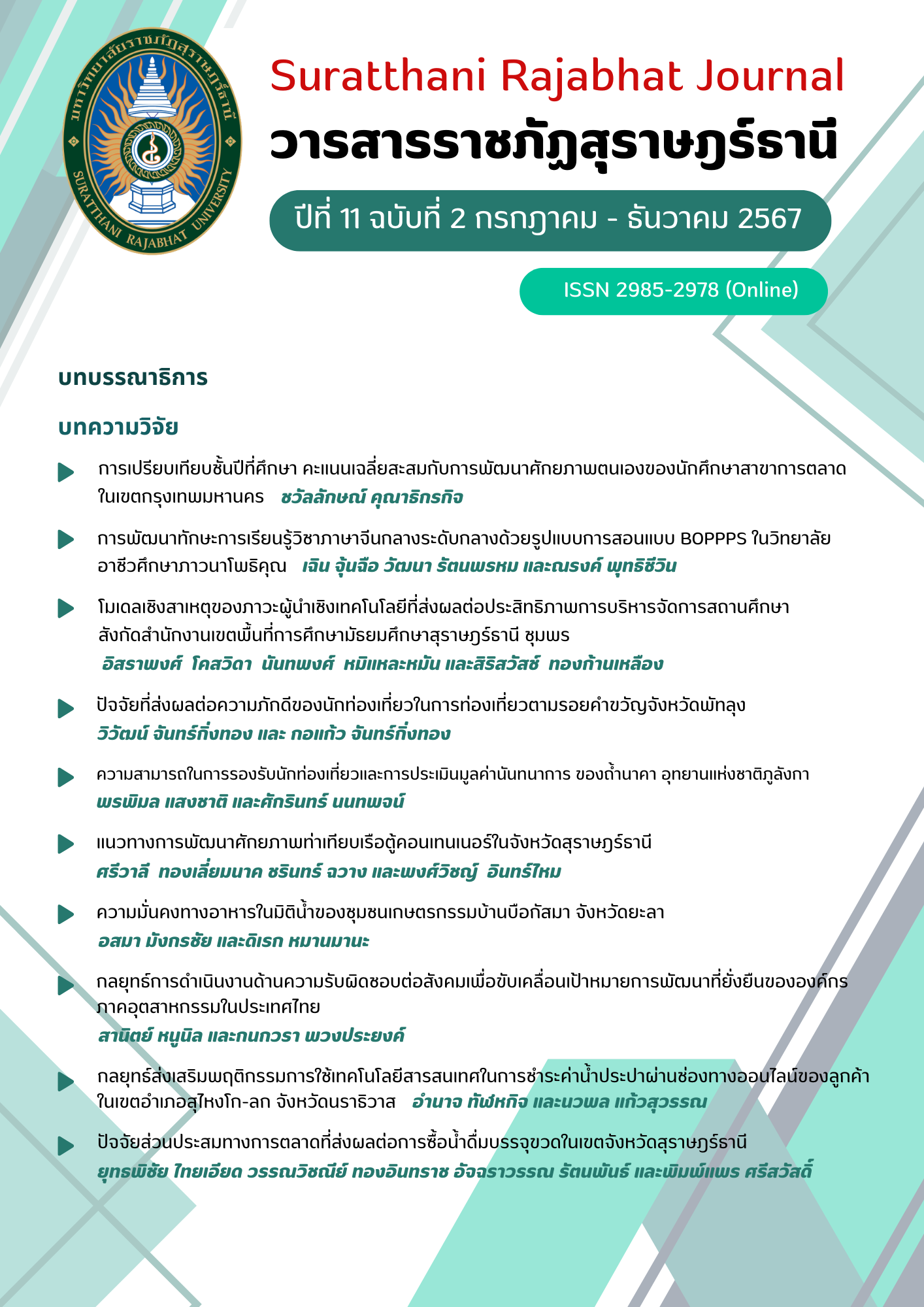A Casual Model of Technological Leadership Affecting the Management Efficiency of Schools under the Secondary Educational Service Area Office of Surat Thani and Chumphon
Main Article Content
Abstract
The objectives of this study were 1) to examine the existing conditions, desired conditions, and strategies for cultivating technological leadership 2) to construct a Casual Model of Technology Leadership Affecting the Efficiency Administration and 3) to validate the structural accuracy of a Casual Model of Technology Leadership Affecting the Efficiency Administration. The sample group Educational institution administrators and teachers, totalling 560 people. The data collection in this study consisted of a questionnaire and an interview. The statistical techniques employed for data analysis encompassed frequency, percentage, mean, standard deviation, t-test, Structural Equation Modeling (SEM), and content analysis.
The results indicated that 1) the technological leadership of school administrators institution administrators Overall, are at a high level. There were observed at 0.01. Furthermore, Including educational institution administrators should focus on personnel development. To have digital technology skills to become professional. Know how to use technology 2) The study examined the impact of technological leadership on the administrative efficiency of school administrators. A Casual Model included six elements and 22 indicators. These elements were: (1) leadership and vision, consisting of three indicators; (2) the creation of learning environments in the digital age, consisting of four indicators; (3) being citizens in the digital age, consisting of four indicators; (4) systematic improvement, consisting of four indicators; (5) excellence in practice, consisting of four indicators; and (6) the efficiency of school administrators, consisting of three indicators. The average score for the efficiency of school administrators was 4.85, indicating a high level of efficiency. Lastly, 3) A Casual Model of Technology Leadership Affecting the Efficiency Administration was found to consistent with the empirical data (Chi-Square=143.58, df=138, P-Value=0.35, x2/df=1.04, CFI=0.91, TLI=0.92, RMSEA=0.04,). These results indicated the model explains a significant amount of the variance in the administrative efficiency of school administrators, with an average explained variance of 90%.
Article Details

This work is licensed under a Creative Commons Attribution-NonCommercial-NoDerivatives 4.0 International License.
References
American Institute for Research (AIR). (2009). Evaluation of the school technology leadership initiative: External evaluation report 2. Washington, DC: American Institutes of Research.
Ahmed, S., Ahmed, A. & Ahmad, M. (2017). Application of Multiple Comparison Procedures on an Individual’s Innovative Behavior. Pakistan Journal of Statistics, 3(3), 191–206. https://papers.ssrn.com/sol3/papers.cfm?abstract_id=2982944
Bainbridge, W. (2020). Leadership in Science and Technology : A Reference Handbook. California : SAGE Publications, 14.
Chamchoy, S. (2020). School Management in the Digital Age. (1st edition). Phitsanulok : Naresuan University Press.
Chawanapaisarn, J. (2020). Guidelines on The Development of Technology Leadership of School Administrator in the Tawaravadee Consolidation under The Secondary Education Service Area Office Suphanburi. Department of Educational Administration Graduate School, Silpakorn University.
Ingard, A. (2022). Determining an Appropriate Sample Size and Power of Test with Strength Degree of the Relationship between Variables in the Structural Equation Modeling. MUT Journal of Business Administration, 19(1), 106-121. https://so04.tci-thaijo.org/index.php/journalmbsmut/article/view/259623.
International Society for Technology in Education (ISTE). (2009). National Educational Technology Standard for Administrators. https://shorturl.asia/EX4vm
Keesookpun, A. (2021). School Management in Digital Era. https://www.trueplookpanya.com/knowledge/content/52232/-edu-teaartedu-teaart-teaartdir.
Office of the Basic Education Commission. (2022). Educational development plan of the Basic Education Commission. Bangkok : Ministry of Education.
Pawabutra, C. (2020). Technological Leadership Development Model for the School Administrators in the Digital Age. Journal of Education Administration and Leaderchip, 9(33), 1-11. https://jeal.snru.ac.th/ArticleView?ArticleID=842
Rabadán, P. & Pérez, G. (2020). Improved method for the detection of catheter colonization and catheter-related bacteremia in newborns. Diagn Microbiol Infect Dis, 87, 311-314.
Sutthirak, S. & Leadkaew, S. (2021). Structural Equation Model of Factors Influencing Performance of Community Enterprises. Journal of Social Science and Buddhistic Anthropology, 6(8), 431-447. https://so04.tci-thaijo.org/index.php/JSBA/article/view/250880.
Siobhan, C. & Jason, W. (2019). Top 5 IT Leadership Trends In 2019 : A CIO Report. https://gomindsight.com/insights/blog/top-5-it-leadership-trends-cio-report.
Thannimalai, R. & Raman, A. (2019). The Influence of Principals’ Technology leadership and Professional Development on Teachers’ Technology Integration inSecondary School. Malaysian Journal of Learning and Instruction, 15(1), 203-228. https://www.researchgate.net/publication/326802539_The_Influence_of_Principals'_Technology_Leadership_and_Professional_Development_on_Teachers'_Technology_Integration_in_Secondary_Schools
The Secondary Educational Service Area Office Suratthani Chumphon. (2021). Action Plan 2021. Suratthani : Policy and Planning Group.
Thongkanluang, S. (2020). Model Development on the 21th Century Learning Management Competency that Affects to Learner Quality of Teachers in Surat Thani Province. Journal of Education, Prince of Songkla University, Pattani Campus, 33(1), 94-110. https://so02.tci-thaijo.org/index.php/edupsu/article/view/243477/172073
Tripongpun, K. (2022). Confirmatory Factor analysis of tourism safety for foreign female tourists. Suratthani Rajabhat Journal, 9(1), 40-75. https://so05.tcithaijo.org/index.php/srj/article/view/253876/174660.


